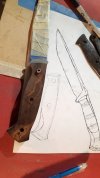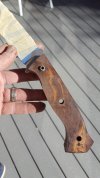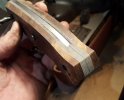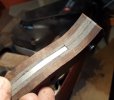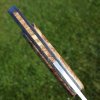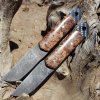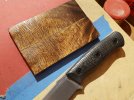Fighters usually balance near the guard. Due to the short blade length there was no need to keep weight in the butt of the tang to get achieve this. Being a utility knife it would also be appropriate to balance on the first finger. This knife balances at a point about midway between those two points.
A problem with many classic ABS style fighters is they make the tip and the butt very light with distal taper and a stick tang and a weighted guard which makes the knife rotate quickly and feel really light and lively at their table but historically stabbing weapons were not like this and had more weight on the ends to resist deflection. You would often see a very stout point and a weighted pommel. This little knife, however, isn't really a full-on fighter and its moment of inertia is somewhere between an "ABS style knife" (which in my opinion are wrong) and a real historic weapon. It's a "tactical fixed blade" that can pry open a glove box (a pure fighter isn't intended to pry, but soldiers frequently do) defeat body armor, hammer through masonry and function as a utility fixed blade to open boxes and clean your fingernails. It just also happened to be designed to also function as a weapon. Some aspects of this design are a grip (contouring, guard and thumb ramp and handle flare) that fit while laid across the hand at an angle in order to project reach. The Shiv is specially contoured to sit straight and will align naturally with the arm (not jut out at an angle, try that with other knives) but there were some minor compromises to this grip on the UF to help it stay compact and lay flat which was important to the other collaborator, Jason. Still, the point location is intuitive without having to look.
A key element to functioning as a modern tactical fixed blade is accommodating a reverse grip. If your thumb can't get around the end of the handle while held in a reverse grip it isn't a proper modern tactical fixed blade. It might be a very nice knife, but that wasn't what we were going for. That said I really like the design the OP put forward. It looks beautiful and I'll bet it feels great. But it won't be optimized for the function we envisioned for this knife, though it may be perfect for his goals, which is cool.



